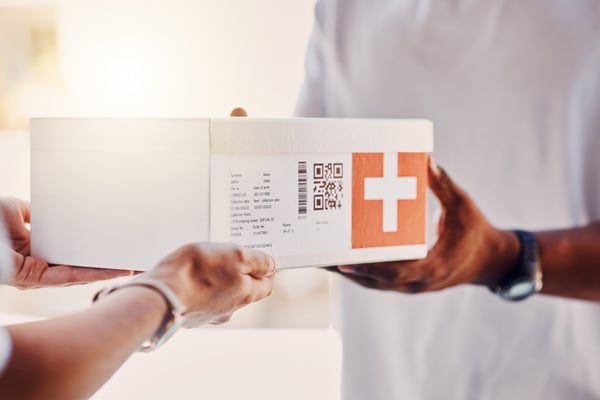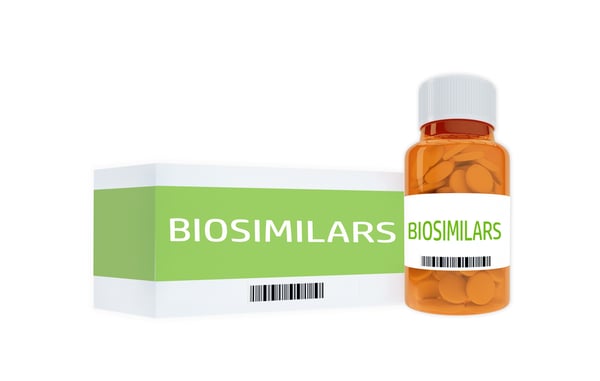Pharmacy Industry Trends: What to Watch For

From biosimilars to artificial intelligence, these are the trends poised to take community pharmacy by storm.
The pharmaceutical industry is ever changing. Many of these changes—be they biosimilars, new methods of medication delivery, or even new diseases having their moment in the research and development spotlight—will trickle down to the pharmacy level. It is important for community pharmacists to stay up to date on the latest and greatest innovations and advancements to continue providing the best care to their communities and patients.
“We are in an era where the velocity of scientific advancement is unlike another time in history, and the types of therapeutics being discovered and coming to market are revolutionary,” said Sonia T. Oskouei, PharmD, vice president of biosimilars at Cardinal Health. “From curative treatments with cell and gene treatments to the development of mRNA technologies for vaccines, this innovation is changing how we look at disease overall.”
The industry is also seeing growth in competition for innovator biologics that are critical to treating some of the most severe and chronic diseases via the growing biosimilar market.
With these changes, there is an increased demand and interest in elevating the role of community pharmacists, including in the education, advocacy, and delivery of drugs. “This, I feel, is long overdue, given that full activation of pharmacists in communities is one of the strongest tools we have in expanding and extending patient care, enabling a more equitable and effective health care delivery system,” Oskouei said.
Mergers and acquisitions are also having an impact on independent pharmacists. For example, Walgreens and Amazon have begun acquiring physician practices, and CVS recently announced it they will acquire Signify Health1 and its network of 10,000 clinicians across 50 states; the health tech platform helps organizations create value-based programs that increase metrics and keep patients healthy at home longer.
“Everyone is intrigued about the acquisitions that have been going on, and it’s becoming apparent that dispensing prescriptions alone is not enough to survive in the pharmacy industry while health care groups need to lean on pharmacy to better support metric goals and patient health,” said Lindsay Dymowski, CEO at Centennial Pharmacy Services. “Organizations are starting to pair pharmacy with integrated health networks and utilize pharmacy to support value-based programs.”
More than perhaps ever before, policy activities are influencing how health care is delivered, from the Inflation Reduction Act of 20222 and the prescription drug pricing provisions3 to the Ensuring Innovation Act4—all of which affect pharmacy and pharmacists.
Paige Clark, RPh, vice president of pharmacy programs and policy at Prescryptive Health, noted that one pharmacy this year is the Federal of the main policy actions affecting Trade Commission (FTC) investigation of pharmacy benefit managers (PBMs), announced on June 7, 2022. The investigation takes place amid growing pressure from legislators and the introduction of the bipartisan Pharmacy Benefit Manager Transparency Act of 20225 by Senator Chuck Grassley (R-Iowa) and Senator Maria Cantwell (D-Washington).
“We’re seeing an increased scrutiny of PBMs. If any regulation comes forth from the FTC probe, it will impact pharmacies greatly,” Clark said. “Independent pharmacies have long pushed for PBM reform because many believe their choice and influence have been severely limited with traditional PBM operations and contracts. For independent pharmacies in particular, it is even more imperative that they seek partners to offer profitable solutions. Traditional PBMs have significantly impacted ongoing profitability, so selecting a transparent PBM partner to assist in increasing pharmacy profitability is critical.”

New Medication Delivery Trends
Beckie Fenrick, PharmD, MBA, chief pharmacy officer at pharmacy benefits consulting firm AlignRx, noted that one of the most pressing issues in the industry today concerns gene therapy access and payment.
“While these treatments are truly unique and may bring benefit to certain impacted individuals, the cost for gene therapies easily exceeds $1 million,” she said. “Payment model innovation is needed to assure access. This might include regular insurance, installment payments, risk pool establishment, and outcomes-based contracts for the gene therapy.”
Gene therapies are utilizing new medication delivery trends. Voreti-gene neparvovec-rzyl (Luxturna) is one such prescription gene therapy that treats inherited retinal diseases caused by mutations in both copies on an individual’s RPE65 gene.6,7 The therapy utilizes a “viral envelope” to deliver the treatment: other gene therapies utilize the patient’s bone marrow stem cells to deliver the therapy.
Laura Cranston, a strategic growth consultant to Aspen RxHealth and CEO emeritus of Pharmacy Quality Alliance, noted that complex drugs are constantly coming to the market, requiring new and consistent counseling. New dispensing systems for high-cost drugs, especially those delivered via dispensing machines put in patient homes, are also something that is infiltrating the industry.
“Just because the device is in the patient home, they still necessitate patient education,” Cranston said. “Some of the devices are used for $15,000-per-month medications, where they can monitor down to the minute of the day the patient is taking it; but what about the education and persistence? Who better to do this than pharmacists?”
Pharmacy delivery, rather than pharmacy window pickup, is a growing trend in general. Community pharmacies are offering more transparent, reliable, and affordable delivery services to compete with mail-order pharmacies and give patients the convenience they want.
“Our world is starting to be more comfortable with everything being shipped or hand delivered, and medication is no exception. But patients still trust their local pharmacy delivery over mail-order pharmacy,” Dymowski said.
A Focus on Public Health
During the pandemic, pharmacists assumed a key public health role by administering vaccinations and COVID-19 tests. They also recommended, dispensed, and in some cases prescribed COVID-19 treatments.
“The way community pharmacy scaled in the middle of a pandemic to deliver hundreds of millions of vaccinations to the public has proved it as a true member of the health care team and indispensable partner to the health care sector,” Dymowski said. “The health care world was looking for a sustainable and scalable approach to engage with patients, particularly if there was a threat to public health, and community pharmacy stepped up to serve that need.”
The community pharmacy has clinically trained professionals, vast networks, and suitable infrastructure to connect with patients month after month. It can obtain data, provide prevention and treatment services, and build trust to achieve the outcomes needed.
More than a dozen states allow “test and treat” programs, which enable pharmacists to perform a point-of-care test, such as a rapid test for strep throat, and then prescribe the medication to treat them through a collaborative care agreement with a health care provider.
“There are also a few states that are looking into allowing pharmacists to prescribe medications for other general conditions, under the same type of collaborative practice agreement,” Dymowski said. “Roles are also becoming more patient care–focused, with disease state management and medication therapy management becoming common practice in the day-to-day of a pharmacist.”

Biosimilars Gaining Traction
Biosimilars are developed with the promise of increasing access and lowering costs for biologic therapies, which represent the most expensive drug category in the world. By offering more options and interchangeability designation, the industry can further enhance patient accessibility to biologics at a lower cost through automatic substitution authority. Since biosimilars first launched in the US market in late 2015, the FDA has approved nearly 38 biosimilar products, 22 of which are commercially available as of August 2022.8
“Up until [2021], biosimilars had primarily been developed for the oncology and rheumatology therapeutic areas, but we’re now watching biosimilars launch in ophthalmology and diabetes care,” Oskouei said. “With this expansion, we are getting the opportunity to realize the benefits of biosimilars across other sites of care and moving into pharmacy benefits.”
Biosimilars are a great opportunity for pharmacists to educate and advocate for patients—even more so with the new interchangeability designation. “Interchangeability means that the biosimilar is expected to produce the same clinical result as the reference product in any given patient, which can be demonstrated through switching studies in which patients are switched between the reference product and the biosimilar multiple times,” Oskouei explained. “For products that gain this designation by the FDA, pharmacists may automatically substitute the branded biologic with the biosimilar—as done routinely with brand and generics—per state laws.”
Another massive trend is the adalimumab (Humira) shake-up. After more than 20 years of market exclusivity, adalimumab—once the best-selling drug in the world—will be facing competition with at least 6 biosimilars coming to market—something the health care industry is closely watching.
“Ultimately, bringing biosimilars to market enables pharmaceutical manufacturers to afford the next generation of innovative treatments, while also giving more access to patients,” Oskouei said. “With more biosimilars that fall under pharmacy benefits gaining FDA approval, we could see a huge increase in health cost savings, with some estimates that savings from biosimilars will increase to $133 billion by 2025.”
Pharmacists will play a key role in the advocacy of biosimilars as more come to market and more patients begin to use them. “As the number of biosimilars grows, pharmacists can play a key role in assuring their uptake by ensuring patients understand that biosimilars are not generics and that they undergo extensive testing before they are granted FDA approval,” Fenrick said. “That testing assesses that there are no significant differences between the original reference product and the biosimilar.”
Looking Ahead
From a retail pharmacy perspective, the evolving reimbursement model for Medicare Part D from primarily a direct and indirect remuneration fee perspective to point-of-sale discounts is something that many pharmacists are paying attention to.
“There will be more transparency for [pharmacists] around drug reimbursement, but the reimbursement pressure will likely still be there,” Dymowski said. “Thus, retailers will need to evolve again from a fee-for-service model to ultimately a value-based provider, where medical is heading.”
Clark noted that bringing technology to pharmacies nationwide is a tremendous opportunity to empower consumers and patients. For example, artificial intelligence can help pharmacies stay competitively priced while still providing value for consumers, making them more successful in expanding what they are able to do for patients in community settings.
“On the consumer side, they want modern communication with their pharmacists, so pharmacies will need to adapt accordingly,” Clark said. “In fact, 47% of consumers rated technology as a top requirement for retaining their business, even more than being the lowest-cost pharmacy.”
References
- CVS Health to acquire Signify Health. News release. CVS Health. September 5, 2022. Accessed September 13, 2022.https://www.cvshealth.com/news-and-insights/press-releases/cvs-health-to-acquire-signify-health
- By the numbers: the Inflation Reduction Act. The White House. August 15, 2022. Accessed September 13, 2022. https://www.whitehouse.gov/briefing-room/statements-releases/2022/08/15/by-the-numbers-the-inflation-reduction-act/
- Senate passes prescription drug pricing bill. American Society of Health-System Pharmacists. August 7, 2022. Accessed September 13, 2022. https://www.ashp.org/news/2022/08/07/senate-passes-prescription-drug-pricing-bill?loginreturnUrl=SSOCheckOnly
- Senate passes two pieces of Cassidy legislation to lower prescription costs. News release. Bill Cassidy, MD. March 11, 2021. Accessed September 13, 2022. https://www.cassidy.senate.gov/newsroom/press-releases/senate-passes-two-pieces-of-cassidy-legislation-to-lower-prescription-costs
- FTC launches inquiry into prescription drug middlemen industry. News release. Federal Trade Commission. June 7, 2022. Accessed September 13, 2022. https://www.ftc.gov/news-events/news/press-releases/2022/06/ftc-launches-inquiry-prescription-drug-middlemen-industry
- Grassley, Cantwell introduce bipartisan bill to combat rising prescription drug prices and provide more transparency. News release. Chuck Grassley. May 24, 2022. Accessed September 13, 2022. https://www.grassley.senate.gov/news/news-releases/grassley-cantwell-introduce-bipartisan-bill-to-combat-rising-prescription-drug-prices-and-provide-more-transparency
- FDA approves novel gene therapy to treat patients with a rare form of inherited vision loss. News release. FDA. December 18, 2017. Updated March 16, 2018. Accessed September 13, 2022. https://www.fda.gov/news-events/press-announcements/fda-approves-novel-gene-therapy-treat-patients-rare-form-inherited-vision-loss
- Biosimilar product information. FDA. Updated September 8, 2022. Accessed September 13, 2022. https://www.fda.gov/drugs/biosimilars/biosimilar-product-information